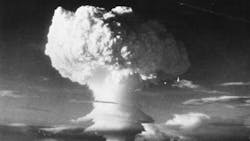In 1942, the man chosen to lead America’s effort to harness the power of the atom was U.S. Army General Leslie Groves.
In less than three years, Groves oversaw the development, construction, and delivery of the atomic bombs that were used against Japan to end World War II.
Groves’ 1962 book -- Now It Can Be Told -- provides tremendous insight into his leadership of the Manhattan Project.
Groves details in unvarnished prose how he successfully managed a continental-wide effort that became the largest and most audacious engineering feat in history.
The book should be required reading for anyone involved in leadership and project management today. It is chocked full of lessons about what to do, and not to do.
Here are just a few lessons that struck me as I recently re-read Groves’ book:
The Start is Half the Deed
Two millennia ago, Roman engineers worked under the mantra “Intitum didium facti”; the start is half the deed. This was expanded in Voltaire’s “the enemy of the good is the perfect”.
An engineer in thought and training, Groves ran the Manhattan Project accordingly: “…The general philosophy I had followed throughout…and to which we adhered consistently in this project: namely, that nothing would be more fatal to success than to try to arrive at a perfect plan before taking any important step.”
Lead, and Then Let Go
The sheer scale of the project meant that Groves and his key leadership team could never be everywhere at once. They had to trust others to get the job done.
Groves wrote, “Another major advantage was that distance alone prevented me from becoming involved in too many details, which is so dampening to the initiative of subordinates.”
Another World War II commander, George S. Patton, concurred, “Never tell people how to do things. Tell them what to do and they will surprise you with their ingenuity.”
Smaller is Better
The project could have easily been overwhelmed by dizzying numbers of committees, meetings, and bureaucracy.
Groves viscerally understood this possibility, and fought it every step along the way. For him, size mattered – and smaller was better.
“I felt that a committee of three was ideal and that any more members would be a hindrance rather than a benefit. I pointed out that I could keep three people reasonably well informed on our major problems, and furthermore, that I would be able to obtain advice from them much more readily than I could from a larger group.”
Exude Confidence, Not Arrogance
While no one knew specifically how the project or its “device” would finally materialize, there was never a moment of doubt about the ultimate triumph that lay ahead.
Groves exuded a reserved, yet perceptible confidence that spread amongst everyone involved. “…I was, of course, assuming that our work would be successful. This was normal procedure. Always we assumed success…”
Do It In-Person
Groves himself -- or one of his tight inner circle -- would personally call on those organizations and individuals deemed vital to the project’s success. This, despite the incredible demands on their time, and in an era when travel across the U.S. was far more difficult and taxing than it is today.
“The importance of extending common courtesy to those with whom you expect to conduct important business…. There is no substitute for it.”
Celebrate the Achievement, Quietly and With Dignity
Groves knew he was part of something historic. For the rest of his life he celebrated– with a quiet dignity- what was accomplished.
“It was a phenomenal achievement, an even greater venture into the unknown than the first voyage of Columbus.”
About the Author
Andrew R. Thomas Blog
Associate Professor of Marketing and International Business
Andrew R. Thomas, Ph.D., is associate professor of marketing and international business at the University of Akron; and, a member of the core faculty at the International School of Management in Paris, France.
He is a bestselling business author/editor, whose 23 books include, most recently, American Shale Energy and the Global Economy: Business and Geopolitical Implications of the Fracking Revolution, The Customer Trap: How to Avoid the Biggest Mistake in Business, Global Supply Chain Security, The Final Journey of the Saturn V, and Soft Landing: Airline Industry Strategy, Service and Safety.
His book The Distribution Trap was awarded the Berry-American Marketing Association Prize for the Best Marketing Book of 2010. Another work, Direct Marketing in Action, was a finalist for the same award in 2008.
Andrew is founding editor-in-chief of the Journal of Transportation Security and a regularly featured analyst for media outlets around the world.
He has traveled to and conducted business in 120 countries on all seven continents.
